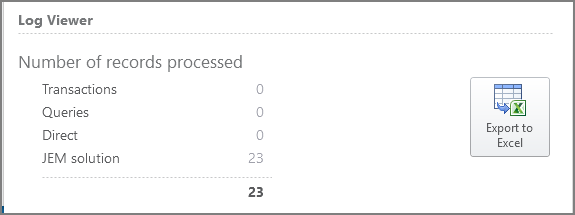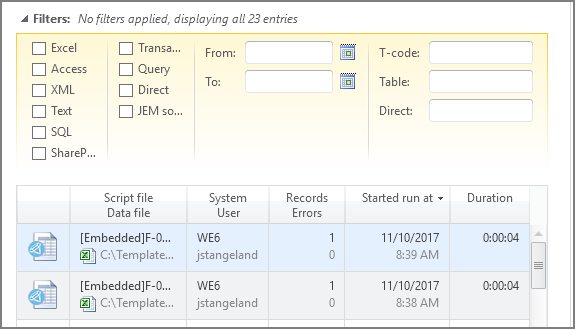View logs and details
The Studio Log Viewer displays a list of all successful and unsuccessful Journal Entry Management (JEM) actions.
View the log entries
- Click the File tab, and then click Log Viewer.
- Click a log entry to see the run details.
At the top of the screen, the Log Viewer shows you the number of records processed through JEM. You can export the logs to an Excel worksheet by clicking Export to Excel.

In the list of log entries, you can see the following:
- The script file name and the data file name
- The SAP system where the script ran
- Who ran the script
- The number of records that were uploaded or downloaded
- The number of errors
- When the run started
- How long the run took

Notes:
If the run was not successful, the log entry has a red background, and you can click the log entry to see detailed information on the right side of the screen. Run issues, under Run details, refers to problems accessing the SAP system. Number of errors, under Transaction details, refers to errors in the data that was being uploaded.
The Log Viewer does not display entries for solutions that are run from the Journal Entry v9.x Excel Add-in.
Filter and sort log entries
If you do not see the log entry that you are looking for, use the options at the top of the list to filter by data file type, operation, or date. Or you can filter by the t-code, the SAP table, or the BAPI that was used for the run.
You can also sort the list by clicking a heading. Some columns contain two headings—for example, Script file and Data file. Click the item you want to sort by.
Log entry details
When you click an entry in the list, more information appears on the right side of the screen under Details. ROI details are at the bottom of the screen.
Script details
Script type: Transaction, Query, or BAPI
Script file: The file name
Script path: The script file's location
Data file details
Data type: The program used to make the data file
Data file: The file name
Data path: The data file's location
SAP details
SAP system: The system logged on to for the transaction
SAP user: The person who logged on to the SAP System
SAP client: The client used for the run
Credentials: Connect or Foundation
Run details
Triggered by: Whether the run was triggered manually or scheduled
Started run at: When the run started
Run time: How long the run took
Repeats: For scripts that are scheduled to be run daily, weekly, or monthly
Next run time: For scripts that are scheduled to be run in the future
Run reason: The run reason entered for this script
Run issues: Any problems with the connection to SAP
Run action: Post, Park, or Save as Completed
Run log: The document number and company code
Transaction details
Transaction code: The code used for the Transaction script
Run mode: Standard, Batch Input, or GUI Scripting
Number of records: The number of records processed during the run
Number of errors: The number of errors during the run
ROI details
Manual: How long it would take someone to enter the data directly into SAP
Automated (per record): How long it took Winshuttle Studio to enter the data into SAP
Time saved: The difference between Manual and Automated
Total time saved: The time saved for all records in the run
Template details
Business process: The business process used
Number of headers: In a cell-based solution, this will always be 1
Number of line items: The number of line items posted
Posting log: The document number with the company code and the fiscal year
Extended log: More details about the run, including error messages
Fiscal year: The fiscal year specified; the default is the calendar year
Document id: The document number returned from SAP with the company code and the fiscal year
Attachment details: List of attached files
 Home
Home Contents
Contents Product Help
Product Help Support
Support Print
Print Feedback
Feedback
 Back to top
Back to top Trademarks
Trademarks